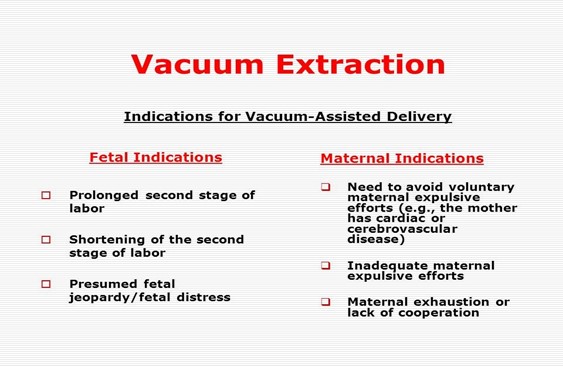The most common indication for a vacuum-assisted delivery is:
Prevention of fetal abnormalities.
Prevention of maternal hemorrhage.
Prolonged second stage of labor.
Prolonged first stage of labor.
The Correct Answer is C
The most common indication for a vacuum-assisted delivery is a prolonged second stage of labor, which means that the mother has been pushing for an extended period without effective descent of the fetal head. The vacuum can help to provide traction to the fetal head and assist with delivery.
Option A is incorrect because a vacuum-assisted delivery is not indicated for the prevention of fetal abnormalities.
Option B is incorrect because a vacuum-assisted delivery is not indicated for the prevention of maternal hemorrhage.
Option D is incorrect because a prolonged first stage of labor is not an indication of
vacuum-assisted delivery. In this case, other interventions, such as augmentation of labor with oxytocin, may be used.

Nursing Test Bank
Naxlex Comprehensive Predictor Exams
Related Questions
Correct Answer is C
Explanation
Betamethasone is a corticosteroid that enhances fetal lung maturity, which can help reduce the risk of respiratory distress syndrome and other complications in preterm infants. It does not reduce maternal and fetal tachycardia associated with terbutaline administration, suppress uterine contractions, or maintain maternal respiratory effort and ventilation during magnesium sulfate therapy.
Correct Answer is C
Explanation
This tool helps in assessing the severity of withdrawal symptoms in infants who were exposed to opioids during pregnancy. Based on the Finnegan score, the nurse can implement appropriate interventions to manage the symptoms and prevent complications. While offering the infant a pacifier with a drop of mom's breast milk or tightly swaddling the infant may be helpful for soothing the infant, these interventions may not directly address the underlying hyperreflexia associated with opioid withdrawal. Placing the infant under a radiant warmer is not indicated for managing hyperreflexia.
Whether you are a student looking to ace your exams or a practicing nurse seeking to enhance your expertise , our nursing education contents will empower you with the confidence and competence to make a difference in the lives of patients and become a respected leader in the healthcare field.
Visit Naxlex, invest in your future and unlock endless possibilities with our unparalleled nursing education contents today
Report Wrong Answer on the Current Question
Do you disagree with the answer? If yes, what is your expected answer? Explain.
Kindly be descriptive with the issue you are facing.
